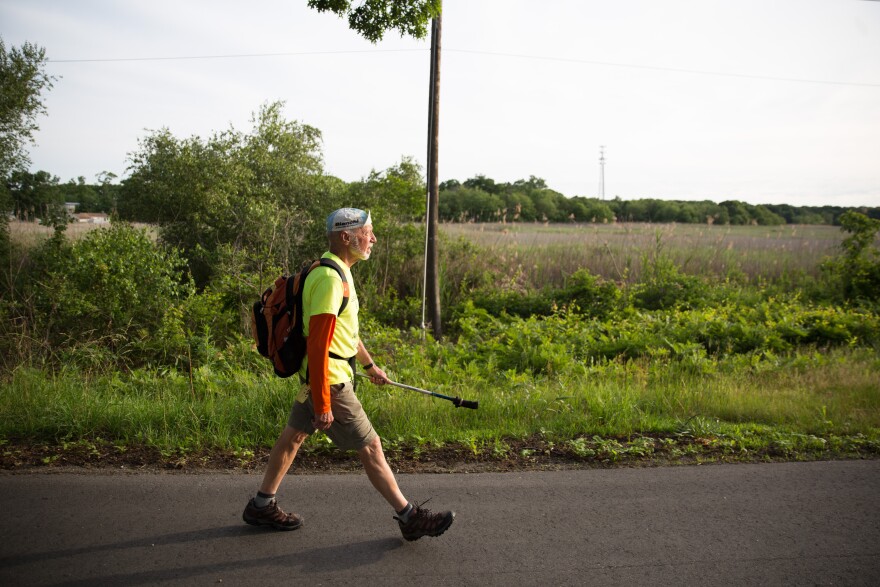Ray Rauth transplanted from New York City to Connecticut 30 years ago. Rauth thought he’d moved out to the country, but the roads near his home felt too dangerous for a quiet stroll.
This summer, the 75-year-old pedestrian advocate walked Connecticut’s coast to draw attention to the state’s most dangerous road for pedestrians: The Boston Post Road.
Colonial postmen once rode horses along the Post Road to deliver the country's first newspapers between New York and Boston. Today, the road’s called U.S. 1. It runs along the East Coast with up to six lanes of traffic—and few sidewalks.
At the foot of a highway overpass in Fairfield, wedged between a Stop and Shop supermarket and a senior living center, Rauth waited at a crosswalk.
Cars shot off Interstate 95 onto U.S. 1 at about 50 miles an hour.
“I’m kind of not willing to chance it here,” Rauth said.
And with good reason. Cars struck and killed 10 pedestrians on this road in Connecticut between 2012 and 2014. A road safety group called the Tri-State Transportation Campaign said that’s the most pedestrian deaths on any road in the state.
Rauth considered this intersection one of the scariest.
“There's a crosswalk, but they're not required by law to stop unless a pedestrian is in the crosswalk,” Rauth said.
Rauth wore a neon yellow shirt and waited at the edge of the sidewalk, ready to cross the street. Not a single car slowed down for him. He said a person should be able to walk or bike to any place they could get to by car, but that’s not easy to do on this road.
“There’s just so much traffic, there’s nowhere for people to go, and it was just never designed for pedestrians in mind,” said Eric Jaffe.
Jaffe drove U.S. 1 from New York to Boston while writing his book on the history of the Boston Post Road, called “The King’s Best Highway.” Jaffe said U.S. 1 became the nation’s first highway in the 1920s, then Interstate 95 replaced it.
“When the final section of 95 was laid out in the 60s, the ceremony was actually officials dressed up in colonial garb riding a buggy down 95,” Jaffe said, “They wanted to pay homage to the Post Road predecessor.
That new interstate, I-95, is a controlled access highway. It runs alongside U.S. 1 and moves cars faster than 65 miles an hour—and spits them out on exit ramps. Not pedestrian-friendly at all.
U.S. 1 became something else: a local road lined with strip malls and gas stations, or what Jaffe calls "wall-to-wall retail junk." Hardly better for pedestrians and cyclists.
Tom Maziarz at the Connecticut Department of Transportation wants to change that. Maziarz said the department is shifting focus away from cars and drivers.
“What we’re facing here, in virtually every state in the country, is the need to gradually retrofit our existing roadway system,” Maziarz said. “We are doing that slowly, but surely.”

Connecticut passed a law in 2009 that requires road upgrades to include space for pedestrians and cyclists. Every state in New England has adopted a similar “Complete Streets” policy, except New Hampshire.
Maziarz said his department will never downsize all of U.S. 1 to build sidewalks or bike lanes. He said towns can apply for state grants to make smaller changes.
On the Post Road in the City of Milford, Jaelin McKenzie collected wet grass clippings on his leather boots as he walked past shopping malls.
“They didn’t want to finish the sidewalk, I guess,” McKenzie shrugged as he began the second leg of his hour-and-a-half commute.
McKenzie catches the bus from Bridgeport then walks a mile to work at a men’s clothing store. The sidewalk disappears and reappears from block to block.
“I gotta kinda maneuver into the street a little bit to get around the grass,” McKenzie says. “I’ve been walking all my life, so it’s something I’m really used to.”
Cars flew by McKenzie, with no speed limit signs in sight. He sometimes walked a road shoulder less than a foot wide. McKenzie said Milford needs a real sidewalk.
Not every town can afford that, but pedestrian advocate Ray Rauth said some fixes come cheap. Enforcing speed limits and widening shoulders are both easy ways to keep walkers safe.
“There are a lot of people that know the roads from the standpoint of a pedestrian or cyclist, and their opinion should be asked for by the people who build the roads,” Rauth said.
The state DOT will rewrite the highway design manual this summer, and Rauth said he wants to share his ideas. Ideas about how to make roads safe for pedestrians like him—on their way to work, or out for a country stroll.
This report comes from the New England News Collaborative, eight public media companies coming together to tell the story of a changing region, with support from the Corporation for Public Broadcasting.






